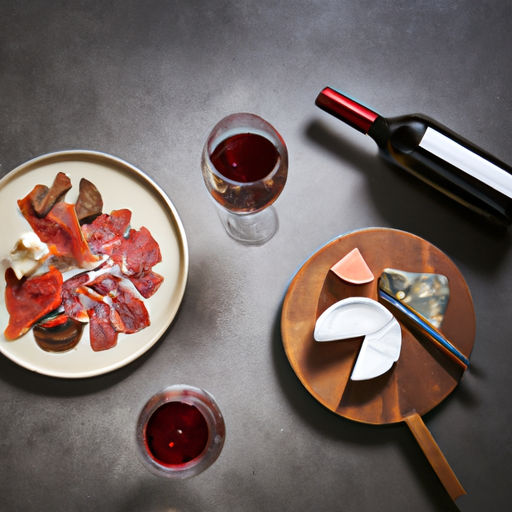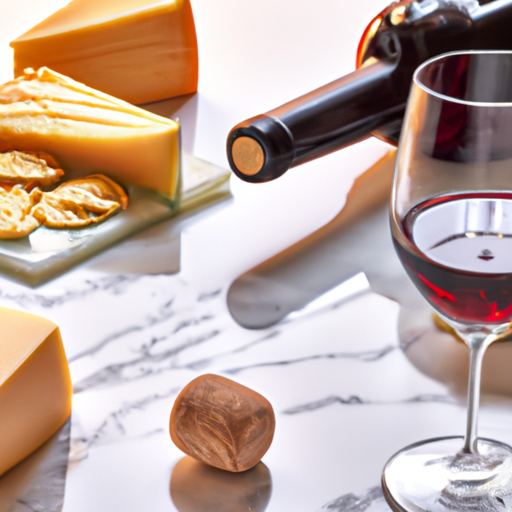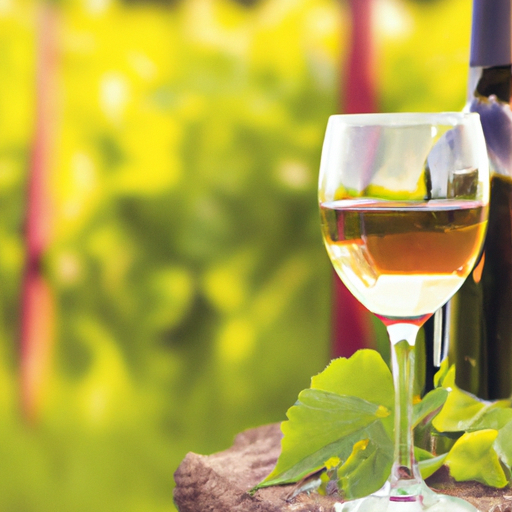Are you a foodie who loves to explore new flavors and indulge in the finer things in life? Well, then you’re in for a treat! Have you ever wondered about the art of pairing food and wine? It can be a daunting task, but fear not, because we’ve got some amazing tips that will elevate your dining experience to a whole new level!
When it comes to food and wine pairing, there are a few basic principles that you should keep in mind. First and foremost, it’s all about balance. The flavors of the food should complement the characteristics of the wine, and vice versa. Sweet and spicy dishes, for example, pair well with wines that have a hint of sweetness to them.
But there’s more to it than just sweetness and spice. The acidity, tannins, and body of the wine also play a key role in determining the perfect pairing. Don’t worry if this sounds a bit overwhelming right now – we’ll delve deeper into these concepts in our upcoming article. So stay tuned to discover some delicious combinations that will make your taste buds dance with joy!

Understanding the Basics of Food and Wine Pairing
When it comes to enjoying a delicious meal, the right wine can truly enhance the flavors and elevate the dining experience. Understanding the basics of food and wine pairing can help you create harmonious combinations that will tantalize your taste buds. In this article, we will explore the key factors that influence food and wine pairing, as well as provide some tips and guidelines to help you make the perfect match.
Taste and Flavor Profiles
When pairing food and wine, it is important to consider the taste and flavor profiles of both. The primary tastes are sweet, sour, bitter, salty, and umami. Each dish and wine will have a different combination of these tastes, and finding a balance between them is essential for a successful pairing.
Additionally, the flavor profiles of food and wine should complement each other. For example, a wine with fruity notes may pair well with a dish that has similar fruit flavors. Conversely, a wine with earthy or spicy flavors may be better suited for a dish that has similar characteristics.
Acidity and Sweetness
Acidity and sweetness are important elements to consider when pairing food and wine. Acidity in wine can cut through and balance the richness of certain foods, such as fatty meats or creamy sauces. For example, a wine with high acidity, such as Sauvignon Blanc, can complement a buttery seafood dish.
On the other hand, sweetness in wine can balance and enhance the flavors of spicy or salty foods. For example, a slightly sweet Riesling can pair wonderfully with spicy Asian cuisine or a salty cheese.
Body and Weight
Another factor to consider when pairing food and wine is the body and weight of both. The body of a wine refers to its texture and mouthfeel, which can range from light-bodied to full-bodied. In general, lighter-bodied wines pair well with lighter dishes, while full-bodied wines can stand up to more robust flavors.
The weight of a dish refers to its richness and intensity. For example, a heavy steak would require a full-bodied red wine to match its intensity, while a light salad would be best complemented by a lighter white wine.
Pairing Red Wine with Food
Red wine is often associated with rich flavors and is a popular choice for pairing with various dishes. Here are some guidelines for pairing red wine with different types of food:
Grilled Meats with Bold Reds
When it comes to grilled meats such as steak or lamb, bold red wines with high tannins are an excellent choice. The tannins in the wine help cut through the fatty flavors of the meat, creating a balanced and enjoyable combination. Cabernet Sauvignon or Syrah are classic choices for pairing with grilled meats.
Light Reds with Fish and Poultry
Contrary to popular belief, red wine can also be paired with fish and poultry. Opt for lighter red wines such as Pinot Noir or Beaujolais when pairing with delicate fish or roasted chicken. These wines have lower tannins and lighter bodies, allowing them to complement the flavors without overpowering them.
Earthiness with Red Wine
Red wines with earthy or spicy undertones, such as Merlot or Grenache, pair well with dishes that have similar characteristics. For example, mushroom-based dishes or roasted root vegetables can be beautifully enhanced by the earthy flavors of these wines.
Pairing White Wine with Food
White wine offers a refreshing and vibrant choice for pairing with a wide range of foods. Here are some tips for pairing white wine with different types of dishes:
Crisp Whites with Seafood
Crisp and acidic white wines, such as Sauvignon Blanc or Albariño, are perfect for pairing with seafood dishes. The acidity in these wines helps to cut through the rich and sometimes oily flavors of seafood, creating a harmonious combination. Whether it’s grilled fish, shrimp scampi, or oysters on the half shell, these wines will enhance the flavors of the dish.
Fruity Whites with Spicy Dishes
If you’re enjoying a spicy dish, such as Thai or Indian cuisine, consider pairing it with a fruity white wine. Riesling or Gewürztraminer, with their fruity and slightly sweet notes, can help balance the heat and spice in the food, creating a pleasant contrast.
Creamy Whites with Rich Flavors
When it comes to rich and creamy dishes, such as pasta with cream sauce or risotto, opt for a creamy white wine. Chardonnay, especially those that have undergone oak aging, pairs beautifully with these dishes, creating a luxurious and indulgent combination.
Pairing Rosé and Sparkling Wine with Food
Rosé and sparkling wine offer a versatile and refreshing choice for pairing with a variety of dishes. Here are some tips for pairing rosé and sparkling wine with different types of food:
Dry and Refreshing Rosés with Salads and Light Fare
Dry rosés, with their crisp and refreshing flavors, are excellent options for pairing with salads and light fare. The acidity and fruitiness of the wine complement the flavors of fresh greens and vegetables, creating a light and refreshing combination.
Bubbles with Fried Foods and Oysters
The effervescence and acidity of sparkling wines make them an ideal choice for pairing with fried foods. Whether it’s crispy fried chicken or a plate of calamari, the bubbles help cleanse the palate and cut through the richness of the dish. Sparkling wines also pair wonderfully with oysters, enhancing the brininess of the shellfish.
Sweet Rosés with Desserts
For those with a sweet tooth, sweet rosés are a perfect choice for pairing with desserts. Whether it’s a slice of strawberry shortcake or a decadent chocolate mousse, the sweetness of the wine complements and enhances the flavors of the dessert, creating a delightful and indulgent pairing.

Consider Regional Pairings
Matching cuisine with wines from the same region is another approach to food and wine pairing. Many regions around the world have developed traditional food and wine pairings that have stood the test of time. Here are some examples:
Italian Cuisine with Italian Wines
Italian cuisine, known for its diverse flavors and ingredients, pairs beautifully with Italian wines. From the light and crisp Vermentino with seafood pasta to the bold and robust Barolo with braised beef, matching the flavors of the cuisine with wines from the same region can create a seamless and authentic dining experience.
French Cuisine with French Wines
French cuisine is renowned for its sophistication and elegance, and French wines are the perfect accompaniment. From a classic Chardonnay with buttery escargot to a velvety Bordeaux with Coq au Vin, exploring traditional food and wine pairings from France can transport you to the romantic streets of Paris.
Experimenting with Unconventional Pairings
While traditional pairings can be a safe bet, don’t be afraid to push boundaries and try unconventional combinations. Sometimes, unexpected pairings can result in delightful surprises. Here are some tips for experimenting with unconventional pairings:
Pushing Boundaries with Unexpected Combinations
Try pairing wines with unexpected dishes to create unique and exciting flavor combinations. For example, a crisp and acidic white wine paired with a spicy Mexican dish can create an unexpected contrast of flavors that can be surprisingly enjoyable.
Trying Contrasting Flavors
Pairing wines with contrasting flavors can create a harmonious balance on the palate. For example, a sweet dessert wine paired with a salty cheese can create a delightful contrast of flavors that can be truly unforgettable.
Consider the Occasion and Atmosphere
When choosing a wine to pair with your meal, it is also important to consider the occasion and the atmosphere. The right wine can enhance the dining experience, creating a memorable and enjoyable meal. Here are some tips to consider:
Choosing Wine to Enhance the Dining Experience
Match the style and intensity of the wine with the occasion and the atmosphere. For example, a bold and opulent wine can be a perfect choice for a special celebration or a romantic dinner, while a light and refreshing wine can be more suitable for a casual gathering with friends.
Matching Wine with Seasonal and Festive Occasions
Consider choosing wines that are appropriate for the season or the occasion. For example, a crisp and refreshing white wine can be a wonderful choice for a summer barbecue, while a rich and full-bodied red can be perfect for a cozy winter gathering.
Understanding the Art of Wine Tasting
To truly appreciate and enjoy wine, it is important to develop your palate and learn the art of wine tasting. Here are some tips to help you enhance your wine tasting experience:
Developing Your Palate
Practice tasting and describing wines to develop your palate. Pay attention to the aromas, flavors, and textures of the wine, and try to identify the different elements that make each wine unique. With time and practice, you will become more adept at recognizing the nuances of various wines.
Identifying Wine Faults
Learning to identify wine faults can help you distinguish between good and flawed wines. Common faults include cork taint, oxidation, and excessive sulfur. Understanding these faults can help you make informed decisions when selecting wines and ensure that your pairing experience is not compromised.
Utilizing the Five Senses
When tasting wine, engage all five senses to fully experience the wine. Observe the color and clarity of the wine, inhale the aroma, savor the flavors on your palate, and pay attention to the texture and finish. By utilizing all your senses, you can gain a deeper appreciation for the wine and enhance your overall tasting experience.
Beyond Food Pairing: Cellaring and Serving
In addition to food pairing, understanding the art of wine extends to proper storage, aging, decanting, and serving techniques. Here are some important considerations:
Proper Storage and Aging of Wines
If you’re planning to build a wine collection, proper storage conditions are crucial. Wines should be stored in a cool, dark, and humid environment to protect them from heat, light, and dryness. Aging wines can also enhance their flavors and complexities, but not all wines are suitable for long-term aging. Research and consult experts to determine which wines in your collection will benefit from aging.
Decanting and Serving Techniques
Decanting is the process of pouring wine from its bottle into a decanter to allow it to breathe and separate any sediments. This is particularly important for older red wines. When serving wine, consider the appropriate glassware for the type of wine you are serving. Red wines typically benefit from larger, rounder glasses, while white wines are best served in smaller, narrower glasses.
Conclusion
Pairing food and wine is an art form that can greatly enhance your dining experience. By understanding the basics of taste and flavor profiles, acidity and sweetness, as well as body and weight, you can create harmonious combinations that will delight your palate. Whether you choose to follow traditional pairings, experiment with unconventional combinations, or consider the occasion and atmosphere, the key is to enjoy the process of discovering new flavors and creating memorable moments with food and wine. Cheers!






